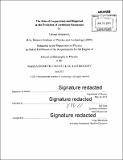The role of cooperation and dispersal in the evolution of antibiotic resistance
Author(s)
Artemova, Tatiana
DownloadFull printable version (7.748Mb)
Other Contributors
Massachusetts Institute of Technology. Department of Physics.
Advisor
Jeff Gore.
Terms of use
Metadata
Show full item recordAbstract
Understanding mechanisms of evolution under in real biological systems is a fundamental problem. Natural selection is one of the mechanisms that drive evolution. Due to the natural selection, phenotypes with higher fitness than the rest of the population increase in frequency and eventually dominate the populations. In real biological systems due to interactions between individuals within a population, it is not always obvious how natural selection manifests itself. Here we consider two types of interactions cooperative antibiotic break down and spatially expanding populations. In each of the cases predicting which phenotype is the most fit and the patterns corresponding to selection of this phenotype could be not straightforward. (1) Bacterial antibiotic resistance is typically quantified by the minimum inhibitory concentration (MIC), which is defined as the minimal concentration of antibiotic that inhibits bacterial growth starting from a standard cell density. However, when antibiotic resistance is mediated by degradation, the collective inactivation of antibiotic by the bacterial population causes the measured MIC to depend strongly on the initial cell density. Given this dependence, the relationship between MIC and bacterial fitness in such cases is not well-defined. Here we demonstrate that the resistance of a single, isolated cell-which we call the single cell MIC (scMIC)-provides a superior metric for quantifying antibiotic resistance. Unlike the MIC, we find that the scMIC predicts the direction of selection and also specifies the antibiotic concentration at which selection begins to favor new mutants. Understanding the cooperative nature of bacterial growth in antibiotics is therefore essential in predicting the evolution of antibiotic resistance. (2) During the expansions of natural populations, new phenotype can emerge. If it is fitter than the rest of the population, it will take over. However, the exact spatial patterns of this process are unknown. Here we show that for a wide class of models the fraction of the fit mutant should increase exponentially. We also observe this pattern experimentally by observing bacterial populations expanding in soft agar, as well as connection between the steepness of the exponent to the fitness difference.
Description
Thesis: Ph. D., Massachusetts Institute of Technology, Department of Physics, 2015. Cataloged from PDF version of thesis. Includes bibliographical references (pages 89-92).
Date issued
2015Department
Massachusetts Institute of Technology. Department of PhysicsPublisher
Massachusetts Institute of Technology
Keywords
Physics.